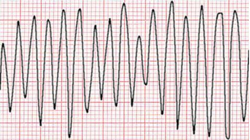| Ventricular flutter | |
|---|---|
 | |
| Specialty | Cardiology |
Ventricular flutter is an arrhythmia, more specifically a tachycardia affecting the ventricles with a rate over 250-350 beats/min, and one of the most indiscernible. It is characterized on the ECG by a sinusoidal waveform without clear definition of the QRS and T waves. It has been considered as a possible transition stage between ventricular tachycardia and fibrillation, and is a critically unstable arrhythmia that can result in sudden cardiac death.[ citation needed ]
It can occur in infancy, [1] youth, [2] or as an adult.
It can be induced by programmed electrical stimulation. [3] [4]